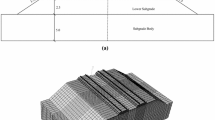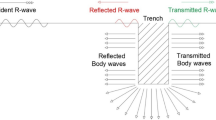Abstract
Train-induced ground vibration is numerically analyzed using the finite element method (FEM) in this paper. Varieties of open trenches including partial and full length systems with different geometries are employed as the vibration mitigation strategies. Ground is modeled by multiple soil layers and the train load pattern is simulated by series of successive moving loads. A parametric study is then carried out after verification of the numerical model. Effects of different parameters including the trench type, size and geometry and the train speed on the vibration mitigation level are investigated. The operational speeds are set to be in vicinity of the Rayleigh wave propagation velocity. Two types of active and passive trenches are considered with three different geometries consisting of rectangular, triangular (wedge) and circular cross sections.
Similar content being viewed by others
References
M. H. Kargarnovin and D. Younesian, Dynamics of Timoshenko beams on Pasternak foundation under moving load, Mechanics Research Communications, 31 (2004) 713–723.
A. D. Senalp, A. Arikoglu, I. Ozkol and V. Z. Dogan, Dynamic response of a finite length Euler-Bernoulli beam on linear and nonlinear viscoelastic foundations to a concentrated moving force, Journal of Mechanical Science and Technology, 24(10) (2010) 1957–1961.
M. H. Kargarnovin, D. Younesian, D. J. Thompson and C. J. C. Jones, Response of beams on nonlinear viscoelastic foundations to harmonic moving loads, Computers and Structures, 83 (2005) 1865–1877.
M. Ansari, E. Esmailzadeh and D. Younesian, Frequency analysis of finite beams on nonlinear Kelvin-Voight foundation under moving loads, Journal of Sound and Vibration, 330 (2011) 1455–1471.
M. Ansari, E. Esmailzadeh and D. Younesian, Internalexternal resonance of beams on non-linear viscoelastic foundation traversed by moving load, Nonlinear Dynamics, 61 (2010) 163–182.
D. Younesian, M. H. Kargarnovin, D. J. Thompson and C. J. C. Jones, Parametrically excited vibration of a timoshenko beam on random viscoelastic foundation subjected to a harmonic moving load, Nonlinear Dynamics, 45 (2005) 75–93.
D. Younesian and M. H. Kargarnovin, Response of the beams on random Pasternak foundations subjected to harmonic moving loads, Journal of Mechanical Science and Technology, 23 (2009) 3013–3023.
X. Sheng, M. Li, C. J. C. Jones and D. J. Thompson, Using the Fourier-series approach to study interactions between moving wheels and a periodically supported rail, Journal of Sound and Vibration, 303 (2007) 873–894.
X. Sheng, C. J. C. Jones and D. J. Thompson, Responses of infinite periodic structures to moving or stationary harmonic loads, Journal of Sound and Vibration, 282 (2005) 125–149.
X. Sheng, C. J. C. Jones and D. J. Thompson, Prediction of ground vibration from trains using the wavenumber finite and boundary element methods, Journal of Sound and Vibration, 293 (2006) 575–586.
L. Hall, Simulations and analyses of train-induced ground vibrations in finite element models, Soil Dynamics and Earthquake Engineering, 23 (2003) 403–413.
G. Lombaert, G. Degrande, J. Kogut and S. Francois, The experimental validation of a numerical model for the prediction of railway induced vibrations, Journal of Sound and Vibration, 297 (2006) 512–535.
H. Takemiya, Simulation of track-ground vibrations due to a high-speed train: the case of X-2000 at Ledsgard, Journal of Sound and Vibration, 261 (2003) 503–526.
X. He, C. Jianguo, W. Pengbo, X. Chaoyi, G. Roeck and G. Degrande, Experimental investigation of railway traininduced vibrations of surrounding ground and a nearby multi-story building, Earthquake Engineering and Engineering Vibration, 8 (2009) 137–148.
Y. B. Yang and H. H. Hung, A parametric study of wave barriers for reduction of train-induced vibrations, International Journal for Numerical Methods in Engineering, 40 (1997) 3729–3747.
Y. B. Yang and H. H. Hung, A 2.5D finite/infinite element approach for modeling visco-elastic bodies subjected to moving loads, International Journal for Numerical Methods in Engineering, 51 (2001) 1317–1336.
R. K. Shrivastava and. NSV. Kameswara Rao, Response of soil media due to impulse loads and isolation using trenches, Soil Dynamics and Earthquake Engineering, 22 (2002) 695–702.
H. Takemiya, Field vibration mitigation by honeycomb WIB for pile foundations of a high-speed train viaduct, Soil Dynamics and Earthquake Engineering, 24 (2004) 69–87.
Y. Deger, Passive isolation of railway induced vibrations by means of secondary buildings, International conference on structural dynamics, 2–5 September 2002 Munich. proceedings of Eurodyn: Vol.2 (2002) 1161–1165.
M. Adam and O. Von Estorff, Reduction of train-induced building vibrations by using open and filled trenches, Computers and Structures, 83 (2005) 11–24.
L. Andersen and S. R. K. Nielsen, Reduction of ground vibration by means of barriers or soil improvement along a railway track, Soil Dynamics and Earthquake Engineering, 25 (2005) 701–716.
S. H. Ju, Three-dimensional analyses of wave barriers for reduction of train-induced vibrations, Journal of Geotechnical and Geoenvironmental Engineering, 130(7) (2004) 740–748.
E. Celebi, S. Firat, G. Beyhan, I. Cankaya, I. Vural and O. Kirtel, Field experiments on wave propagation and vibration isolation by using wave barriers, Soil Dynamics and Earthquake Engineering, 29 (2009) 824–833.
A. Karlstrom and A. Bostrom, Efficiency of trenches along railways for trains moving at sub- or supersonic speeds, Soil Dynamics and Earthquake Engineering, 27 (2007) 625–641.
I. Kato, Y. Terumichi, M. Adachi and K. Sogabe, Dynamics of Track/Wheel Systems on High Speed Vehicles, Journal of Mechanical Science and Technology, 19(1) (2005) 328–335.
A. D. Senalp, A. Arikoglu, I. Ozkol and V. Z. Dogan, Dynamic response of a finite length euler-bernoulli beam on linear and nonlinear viscoelastic foundations to a concentrated moving force, Journal of Mechanical Science and Technology, 24(10) (2005) 328–335.
D. Younesian and M. Sadri, Sensitivity analysis of the rectangular trenches employed in suppression of the highspeed train-induced ground vibrations, Proceedings of the ASME 2010 10th Biennial Conference on Engineering Systems Design and Analysis, July 12–14, 2010, Istanbul, Turkey, ESDA (2010) 24624.
B. Xuecheng, J. Hongguang and C. Yunmin, Accumulative deformation in railway track induced by high-speed traffic loading of the trains, Earthquake Engineering and Engineering Vibration, 9 (2010) 319–326.
Author information
Authors and Affiliations
Corresponding author
Additional information
Recommended by Associate Editor Cheolung Cheong
Davood Younesian received his Ph.D in Mechanical Engineering, from Sharif University of Technology, Iran. He joined the School of Railway Engineering at Iran University of Science and Technology in 2005. He is now an associate professor and dean of the school. Dr. Younesian’s research area is mainly focused on the non-linear and random vibrations and dynamics of structures and railway vehicle systems. He has published more than 90 articles so far in international journals and conference proceedings.
Mehran Sadri received his BSc in Mechanical Engineering from Razi University of Kermanshah and his MSc in Railway Engineering from Iran University of Science and Technology, Iran. His research is mainly focused on finite elements, non-linear vibration and control of railway vibrations.
Rights and permissions
About this article
Cite this article
Younesian, D., Sadri, M. Effects of the trench geometry on vibration mitigation level in high-speed railway tracks. J Mech Sci Technol 26, 2469–2476 (2012). https://doi.org/10.1007/s12206-012-0623-0
Received:
Revised:
Accepted:
Published:
Issue Date:
DOI: https://doi.org/10.1007/s12206-012-0623-0




